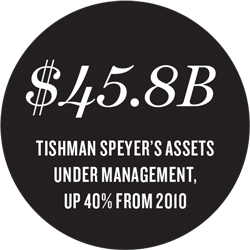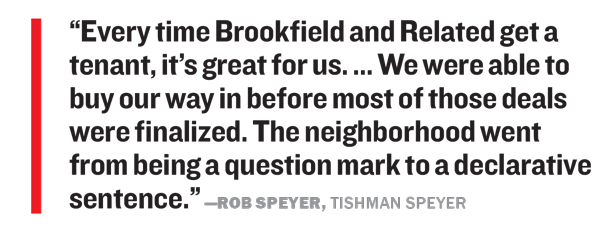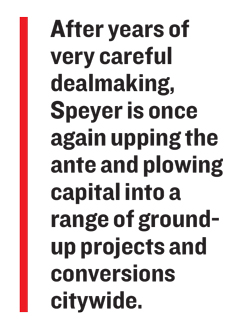Rob Speyer — who took a big reputational blow during the last downturn — is doing everything he can to ensure he doesn’t get burned again.
“When the inevitable correction comes, we’ll have a large margin of safety because of how we’re setting up our capital structures,” the 47-year-old CEO told The Real Deal during an interview at his office at 45 Rockefeller Plaza.
Just over a decade ago, Speyer made the brash $5.4 billion purchase of Stuyvesant Town-Peter Cooper Village. In 2010, he famously defaulted on his loans on the 110-building complex in a move that threatened his family’s reputation and shook his investors’ confidence.
Other New York real estate dynasties, including the Rudins and the LeFraks, had passed on the Stuy Town deal after determining that it didn’t pencil out. But amid a frothy market, with other investors lined up behind it, Tishman Speyer rolled the dice.
Buying the sprawling, largely affordable apartment complex with a parade of more than 15 major investors and a massive loan was undoubtedly a cowboy move.
It turned out to be a mistake that left many in the industry wondering if the baby-faced scion and his company — known for its equity stakes in the Chrysler Building, Rockefeller Center and the MetLife Building — could recover.
Seven years later, Speyer [TRDataCustom] — who was running the company with his father, Jerry, at the time of the Stuy Town deal but has since taken over as CEO — appears to have made a miraculous recovery, restoring his investors’ confidence and then some. Today the firm has a massive $45.8 billion in assets under management, up about 40 percent from 2010, and owns and manages 85.6 million square feet of real estate around the globe, a roughly 45 percent increase from 2010.
 Meanwhile, Speyer and his father (who now serves as the company’s chairman), along with their team of 1,400 employees worldwide, raised $3.9 billion from investors last year alone.
Meanwhile, Speyer and his father (who now serves as the company’s chairman), along with their team of 1,400 employees worldwide, raised $3.9 billion from investors last year alone.
Now, after years of very careful dealmaking, Speyer is once again upping the ante. Perhaps most notably, he’s steering his company away from owning and operating cash-flowing office buildings and toward more commercial and residential construction. He’s plowing capital into a range of ground-up projects and conversions citywide — including a mixed-use tower in Downtown Brooklyn, a five-tower project in Long Island City and a massive Hudson Yards skyscraper — at a time when some analysts forecast potential oversupply in those areas. The firm also has a slew of projects and holdings in other cities, including Los Angeles, Shanghai, London, Frankfurt and Rio de Janeiro.
“We’ve never been more active, either here in New York or globally,” Speyer said.
Yet with all of those deals and developments, his lift is heavier than ever. And industry sources say some of his most recent marquee projects — especially the $3.2 billion Hudson Yards tower — will test his true real estate prowess.
“You can’t take yourself to the next level without taking outsized risks,” said CBRE power broker Mary Ann Tighe, a business associate and friend of Speyer. “You’ve either got yourself a bonanza or you’ve got yourself a failure. With a guy as smart as Rob, you hope that it’s the analysis of that risk that makes the difference.”
Speyer’s spire
Following the Stuy Town disaster, Rob Speyer became noticeably reserved and, at times, cagey.
“You learn from your mistakes and we certainly learned from that one,” said Speyer, who favors talk about the technical makeup of his deals rather than his personal life. “The biggest lesson was about our use of leverage. [Virtually] every investment we’ve had since 2010 has been 50 percent equity and 50 percent debt.”
In a cautious move made even before defaulting on Stuy Town, the company walked away from a deal to buy the development rights to the 26-acre West Side rail yards in 2008. Related Companies acquired those rights shortly after for $1 billion and began its $15 billion Hudson Yards project with Oxford Properties Group.
But, nearly a decade later, Tishman Speyer is gearing up to go head to head with Related in the quickly emerging area. In its most significant move since the financial crisis, the firm shelled out $438 million for a development site at 66 Hudson Boulevard in 2014.
That acquisition was one of Tishman Speyer’s riskiest bets in NYC since Stuy Town — a rare purchase of dirt for a company better known for managing high-profile, already-built towers. And the project came with the daunting task of wooing tenants in an ultracompetitive leasing environment and securing a construction loan at a time when banks were closing their coffers.
To date, Speyer has not secured a single tenant for the planned 2.3-million-square-foot, Bjarke Ingels-designed tower known as the Spiral. That means construction cannot begin.
That’s even as Related has been on a leasing roll lately, signing deals with the likes of asset manager BlackRock — which sources say was also talking to Tishman Speyer — and reportedly negotiating with Morgan Stanley. And nearby, Brookfield Properties is completing its more than 7 million-square-foot Manhattan West project, which has inked leases with the law firm Skadden, Arps, Slate, Meagher & Flom and the National Hockey League.
 Some say Speyer’s Hudson Yards move was cleverly calculated because it allowed his firm to benefit from the first wave of development in the area without taking on the risk of being the first in.
Some say Speyer’s Hudson Yards move was cleverly calculated because it allowed his firm to benefit from the first wave of development in the area without taking on the risk of being the first in.
“They made a decision not [to buy in earlier], but the minute they decided it was working they bought two plots,” said CBRE Vice Chairman Michael Laginestra.
Speyer said he can afford to be patient because the land deal was financed entirely with equity, meaning there’s no ticking time bomb on a loan.
But several insiders said that Tishman Speyer’s building could be handicapped by the fact that unlike Hudson Yards and Manhattan West — which are sprawling, amenitized complexes — it will be a standalone tower.
Speyer disputed that characterization, arguing that his tower will feed off the rival buildings.
“Every time Brookfield and Related get a tenant, it’s great for us,” he said. “We’re their biggest cheerleader. It builds critical mass. We were able to buy our way in before most of those deals were finalized. The neighborhood went from being a question mark to a declarative sentence.”
Tighe said Related’s approach to Hudson Yards would not have worked for most other companies, including Tishman Speyer, whose investors may have wanted quicker returns.
“It’s generally perceived now that Related hit upon the magic formula: Make no money on the office space and make all your money on the residential and retail,” she said. “If you have a capital structure like Tishman Speyer and you’re predominantly an office company, I don’t know how you sell that to your investors.”
Deciding whether to buy the site was clearly a tough call for the firm. Speyer was reportedly prepared to sign the deal right up until the day of the contract signing, but according to New York magazine, he got cold feet at the last minute.
That same day, he and his father took a six-hour walk through the city to discuss the deal, eventually sitting down to tuna sandwiches at a 3 Guys Restaurant on Madison Avenue.
Speyer finally pulled the trigger. “It was the right decision at the time,” he told TRD.
‘Falling in love’
In an industry where many prominent owners prefer to avoid the spotlight, Speyer, who’s married with three children, is often seen as particularly reserved.
In that regard, the apple doesn’t fall far from the tree. His father — a quiet but influential developer who made a name for himself by acquiring trophy buildings in the 1990s — was once described as the antithesis of outspoken contemporaries like Donald Trump and has closely guarded his personal life. One story from 1995 referred to him as “the Forrest Gump of real estate developers.”

Rob Speyer and his wife Anne-Cecilie
Those close to the younger Speyer say he inherited Jerry’s taciturn nature and paired it with his own brand of intensity.
“You wouldn’t call him a back-slappy guy, but he exudes a level of serenity and focus,” said the archbishop of New York, Cardinal Timothy Dolan, a friend. “He may not be popping Champagne corks or dancing on tables, but you can tell he’s having a good time.”
Growing up, Speyer had little interest in the real estate business.
He was a top student at the Dalton School, the elite Upper East Side private school, and a wrestler (he is said to still watch WWE on occasion.) He did a two-year stint at Harvard before transferring to, and graduating from, Columbia University.
In his early to mid-20s, he worked at both the New York Observer and the New York Daily News as a reporter. He wrote about fires in Queens, corrupt landlords, and sex scandals at the prestigious Stuyvesant High School. He famously camped out on O.J. Simpson’s Florida golf course to score an interview and landed himself in prison for a few hours for trespassing.
After a riot broke out at Columbia during his senior year, Speyer rushed to the Observer’s East 64th Street newsroom to crank out a story on deadline, a feeling he described as “falling in love.”
Newspaper reporting exposed him to a whole new world outside his privileged upbringing. “Through journalism, I ended up seeing things, experiencing things that I hadn’t in my childhood, and the texture of the city became much richer than I’d ever understood,” Speyer said.
In some ways, his personality did not seem like a natural fit for real estate, his friends noted.
“Rob is so smart and so focused that it could be intimidating,” said family friend Kathryn Wylde, the head of the business group the Partnership for New York City. “He remains intense and highly focused, but like most people do as they get older, he’s learned how to manage his intensity in a way where it doesn’t intimidate people. I’ve seen his style evolve to be far less threatening.”
Still, Speyer can turn on the heat. The CEO, who also serves as chairman of the Real Estate Board of New York, nearly came to blows with Related’s Chairman Steve Ross last year after they argued over the future of the 421a tax exemption program. The two have since said the incident was overblown.
Insiders also said that Speyer has sought to expand his influence with lawmakers in recent years. In the wake of the Stuy Town debacle, he hired Michelle Adams — the influential executive director of the Association for a Better New York, who also served as an aide to the group’s chairman, Bill Rudin — to oversee Tishman Speyer’s public and government affairs. Sources say she has helped rehabilitate the firm’s reputation and has been key in paving the way for projects in New York as well as assisting in Europe and Asia.
“He brings her to every single REBNY Executive Committee meeting,” one person with knowledge of the meetings said on the condition of anonymity. “You basically can’t talk to him without her.”
Speyer, a registered independent, has an especially close relationship with Gov. Andrew Cuomo. Tishman Speyer was one of Cuomo’s biggest real estate donors, giving $60,800 to his reelection effort.
And in 2014, when Cuomo sought to strike a deal with New York Republicans to ensure his reelection, Speyer reportedly hosted a meeting between the governor and several high-profile members of the party, including the now-disgraced former Republican Senate conference leader Dean Skelos. A spokesperson for Cuomo did not respond to a request for comment.
Top of the Rock
It was Jerry’s decision to purchase Rockefeller Center in 1996 that changed his son’s mind about the real estate business.
The Speyers partnered with Goldman Sachs to pay $900 million for the property, which had slipped into bankruptcy after Japan’s Mitsubishi Estate Company pulled out of its investment.
Standing next to the complex’s ice-skating rink and staring at the renowned Prometheus bronze statue and the throngs of people milling about, Speyer said he suddenly saw real estate as a living, breathing business, rather than just bricks and mortar.

2.3 million-square-foot, Ingels-designed tower
“We spent hours talking about it. It was a defining moment for my father’s career, but it was also the first time the business took on real dimensionality to me,” said Speyer, who started in the company’s leasing group in 1995 and later worked on the renovation of 300 Park Avenue.
With his decision to come aboard, Speyer took the mantle for a family that had accumulated great power and influence through its philanthropy. In the most powerful circles of New York society, the name Speyer goes hand in hand with that of Bloomberg, Weill and even Rockefeller. Rob’s mother, Lynne Tishman Handler, is the great-granddaughter of Julius Tishman, who founded Tishman Realty & Construction in 1898. Her father, Robert, co-founded Tishman Speyer with Jerry as a spinoff of that firm 80 years later.
In 2008, Rob Speyer married Anne-Cecilie Engell, a Danish continuing-education startup founder and the daughter of a retired bigwig at the ocean cargo carrier A.P. Moller-Maersk, which is headquartered in Copenhagen. The two married in a small, intimate ceremony at their Soho apartment, with Jerry serving as best man.
On their honeymoon in the Swiss Alps, Speyer reportedly eschewed the slopes for phone calls with bankers and financial advisors about the declining situation at Stuy Town. Sources said that’s typical for the younger Speyer, who’s often preoccupied with business.
RXR Realty CEO Scott Rechler described setting up an unmarried Speyer with his sister-in-law, only to find that on their double date Speyer wanted to talk shop. Suffice to say, it wasn’t a match.
The 1 percent
Of the total $5.4 billion price for Stuy Town, the Speyers paid about 1 percent — or $56 million — of their own money. The Crown family in Chicago, their longtime partner and a stakeholder in Hilton Hotels and the Chicago Bulls, put up another $56 million. The other 98 percent came from a range of investors.
The Speyers bought the complex from MetLife with plans to quickly upgrade it, raise rents and evict illegal tenants. That immediately sparked a controversy, since the complex was seen by many as a jewel of affordability at a time when Manhattan rents were skyrocketing.
In the end, the company couldn’t fulfill its promise to investors to rapidly increase Stuy Town’s cash flow.
While the failure was largely seen as Rob’s, since he had led most of the negotiations, the deal almost certainly wouldn’t have happened without his father’s input, sources say. Two people familiar with the negotiations said they never saw Jerry in a meeting — yet Rob and his father are said to discuss deals privately.
Tishman Speyer may not have lost much of its own money, but the deal was one of Speyer’s first as co-CEO and was embarrassing.
It was also something of a black eye for the Speyer family — long viewed as civically responsible — to be seen as pushing out struggling tenants.
“He smashed the piggy bank and walked away with the money,” said Benjamin Dulchin, executive director of the Association for Neighborhood and Housing Development, a tenant-advocacy nonprofit. “People lost money, but it wasn’t him — he likely made himself mostly whole again.”
Nevertheless, the failure hit Speyer hard personally.
 “I thought about the different investors who’d signed up to the deal,” he told New York Times reporter Charles Bagli for the book “Other People’s Money,” which chronicled the unraveling of the deal. “It really shook me. Cecilie said to me, ‘What’s going to define you is how you react to this. It’s not the failure. It’s how you deal with the failure.’”
“I thought about the different investors who’d signed up to the deal,” he told New York Times reporter Charles Bagli for the book “Other People’s Money,” which chronicled the unraveling of the deal. “It really shook me. Cecilie said to me, ‘What’s going to define you is how you react to this. It’s not the failure. It’s how you deal with the failure.’”
Some say the failure had a profound impact on Speyer’s confidence.
“He was arrogant before that,” said one person close to him, who asked to remain unnamed. “I don’t think people would necessarily say that about him now. He doesn’t have those same big cojones that he used to.”
Not just Manhattan
While the Speyers’ trophy towers are still important to their branding, they are no longer the family’s greatest sources of income.
California billionaire Donald Bren has accumulated a 97.3 percent stake in the 59-story MetLife Building over the past decade, while Tishman Speyer’s portion has shrunk to less than 3 percent. And the firm owns just 10 percent of the Chrysler Building, with the government of Abu Dhabi now owning a 90 percent stake.
These days, Speyer oversees a handful of less-sexy projects to generate returns. Among those are three Long Island City towers that will house about 1,900 rental apartments and 13,500 square feet of retail space. The project, due for completion next year, will be one of the largest residential hubs ever built in Queens.
The company is also constructing two 27-story office towers totaling 1.1 million square feet and connected by a four-story retail podium. When completed in 2019, the towers will represent the single biggest addition to LIC’s office inventory in more than a quarter of a century.
Speyer admits that his friends thought he was crazy for buying the site in 2003. At the time, the city would drop Rikers Island inmates there upon their release.
But the bet seems to be paying off, and the project looks less risky today than it once did. Against the odds, the two office towers are 75 percent pre-leased to tenants that include the shared-office-space giant WeWork and Bloomingdale’s, which inked a 550,000-square-foot office lease to anchor the project.
“We walked into the room thinking it was a long shot,” Speyer said of the negotiations with the luxury department store. “We walked out of the room thinking, ‘They get it’ and ‘There’s something here.’”
Many describe Speyer’s negotiation style as unwavering. “He doesn’t want to engage in some kabuki dance,” said REBNY’s president, John Banks, who’s worked closely with Speyer on industry initiatives. “He doesn’t get thrown off his game by someone that challenges his position.”
Still, some of Speyer’s old foes have kept close tabs on his latest endeavors. The residential component of the LIC project has drawn criticism from housing advocates, who say it should contain affordable units. The project was grandfathered in under the old 421a program, and as REBNY’s chairman, Speyer played a role in negotiating the agreement.
“That this development was able to slip in without even a minimal affordability requirement is a crime against New York City,” Dulchin said.
As for the company’s first project in Brooklyn, Speyer plans to convert the upper floors of a Downtown Brooklyn building on Hoyt Street, formerly owned by Macy’s, into the “Starrett Lehigh Building of Brooklyn” with creative offices for the hip, tech set.
Tishman Speyer paid $270 million for the top five floors along with the rights to develop a tower on a garage site next door. The company is currently in the planning stages for that project, Speyer said.
Meanwhile, on the West Coast, Tishman Speyer owns several major office complexes in Los Angeles’ tech-centric Playa Vista area and is planning to turn the headquarters of the high-speed transportation company Hyperloop One in the city’s Arts District into an eight-story, 220,000-square-foot office building. While the project has plenty of allure, some observers say prices in the neighborhood may be artificially inflated.
And halfway around the world, the Speyers recently partnered with Lenovo — the world’s largest personal-computer maker — to build a $1.35 billion office community in the wealthy Chinese city of Shenzhen. That project came on the heels of several developments in Shanghai in which Tishman Speyer has significant stakes. In fact, the company has become one of the most aggressive foreign real estate players in China — it’s done more than $9 billion of development and acquisitions there, and its fervor for the market continues even as municipalities impose new measures to cool overheated property prices.
One person who has done business with the firm said the uncertainty of many of those projects could leave Tishman Speyer and its investors exposed.
“It is not an accomplishment to gobble up real estate and pay a big number. None of this means anything until you find out how the deals turn out,” that person said, asking not to be named.
But Speyer shows no signs of letting up anytime soon.
“One of the things about having a global business is that the geographic diversity provides a natural hedge,” he said.
